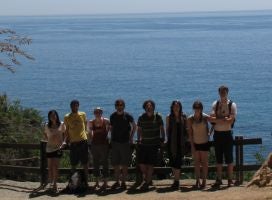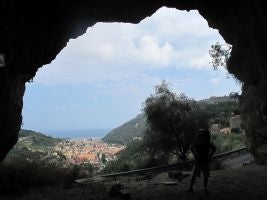
Riel-Salvatore outside the Neanderthal site of Caverna delle Fate in Liguria, Italy
In 1986, the Riel-Salvatore family took a trip to the Lascaux painted caves in southwestern France, and the future of Neanderthal research was impacted forever. "I was one of those really annoying people who knew what they wanted to do when they were nine years old, down to the specific subfield in my discipline," says Anthropology Assistant Professor Julien Riel-Salvatore. At the time, young Julien was obsessed with knights and medieval lore, so on that trip his mother, brother and Julien toured many castles and keeps; almost as an afterthought, they went to see the Paleolithic cave paintings at Lascaux. After seeing the caves, knights were out and early hominids were in. Upon returning home to Montreal, Canada, Julien prized a souvenir children's book showcasing the cave paintings and discussing the prehistoric artists. He keeps that book in his office to this day, next to tomes and textbooks full of the information archeologists, including Julien himself, have gathered on early modern humans.
Julien Riel-Salvatore got his BA at McGill University in 1999 in his hometown of Montreal, going on to do his MA and PhD at Arizona State University. At ASU from 1999-2007, he started the professional relationship he continues to this day with Professor Michael Barton and Regents' Professor Emeritus Geoffrey Clark, world authorities on Stone Age peoples. Says Riel-Salvatore, "They were really great mentors, and they're the people I try to emulate in my relationships with students." After receiving his PhD, he returned to McGill for postdoctoral work before accepting his position at CU Denver in the fall of 2009.

Riel-Salvatore and his crew outside a cave at the Balzi Rossi, Italy
Half Italian himself, Riel-Salvatore grew up speaking Italian, and as a graduate student his focus turned to Italy, where few North American archaeologists were working at the time. His research focuses on the transition from Neanderthals to modern humans, particularly on what happened to Neanderthals. He says, "I moved into a specific research question that nobody was really working on in the early 2000's." This, he says, combined with luck and his familiarity with Italian culture, opened doors to multiple sites and collections in both Northern and Southern Italy. For his doctoral research he worked mostly in the southern Italian region of the Salento, looking at an archaeological culture that was thought to reflect the acculturation of Neanderthals by modern humans. The basic theory at the time was that modern humans moved into the area with more advanced culture and out-competed the existing Neanderthal populations. Riel-Salvatore's PhD dissertation argued that due to a chronological gap between the disappearance of Neanderthals in the area and the arrival of modern humans this was not a likely explanation. His dissertation provided evidence that if Neanderthals had evolved elements of culture they had done it independently, before early modern humans arrived on the scene.
"Part of what I've been trying to do is show that Neanderthals are interesting in and of themselves, and not just in comparison to early humans," says Riel-Salvatore. He came into the field of Neanderthal study at a time when two conflicting theories dominated the field: either Neanderthals were like humans and related to them, or they were vastly different and represented a different species. In the gray area between these two theories, some really interesting questions presented themselves to Riel-Salvatore. What matters most, he explains, is that people come to understand that Neanderthals were different from modern humans, but not so very different. "There's still this sort of misconception where, if you go extinct, then you're a failure in evolutionary terms. Now we are moving away, thankfully, from models where modern humans came in and killed off all the Neanderthals, for which there is no evidence, but many people still look for how Neanderthals were strange or maladapted more than anything else. They look for these differences in the archaeological record and they say, 'Because they were different from humans and because they went extinct, let's find out how these two facts are related.' To me anyway, these questions might not necessarily be the most productive approach."

Riel-Salvatore and his son Mateo in a cave overlooking the town of Finale Ligure, Italy
Riel-Salvatore, along with an expanding number of his colleagues, believes that Neanderthals were a subpopulation of humans, not a distinct species. Neanderthals existed for over 200,000 years, and their remains have been found from Portugal to Siberia and from Northern Europe to the deserts of the Sinai Peninsula, so there would have been vast differences between various populations of Neanderthals themselves. Riel-Salvatore believes the field now has enough evidence to piece together a basic model of what happened when modern humans started radiating out of Africa in large numbers around 70,000-50,000 years ago and encountered Neanderthals. He says, "They were fairly thin on the ground, there were never that many Neanderthals in existence at any one time, so it was basically a numbers game–where the larger population eventually absorbed the smaller population. We have good evidence for this in the genetics now, where we know that up to 4% of the modern human genome is actually inherited from Neanderthals." With clear DNA evidence that Neanderthals interbred with us, Riel-Salvatore sees a strictly biological definition of speciation separating Neanderthals and humans as outdated. He says, "So now we need to come up with ways to explain how we got that small but significant portion of our biological signature from Neanderthals, and this is part of what I've been working towards."
Especially interesting to Riel-Salvatore is finding out more about how Neanderthals thought, and how early modern humans thought about Neanderthals. Determining this can be difficult from what is found at archaeological sites, but not impossible. When archaeologists unearth where ancient peoples lived, they can infer a lot about the individuals that lived there, their habits, capacity for culture and intelligence. Riel-Salvatore has reached conclusions about Neanderthals that challenge much of the traditional conception of them. He says, "Higher-level thinking has been assigned as a uniquely human thing—we think about the afterlife, social messages and conveying thought at a distance—and for a long time that was not granted to Neanderthals." But Riel-Salvatore argues that we now have solid evidence of higher-level thinking in Neanderthals, from artifacts he and other archaeologists have uncovered, giving insight into how they buried their dead, crafted personal ornaments (out of shells, feathers and eagle talons) and from evidence of their painting their faces and bodies. All these behaviors suggest that the social life of Neanderthals was rich and that, while not as complex as that of modern humans, we can recognize in them thinking not so distant from our own. Further, Riel-Salvatore believes that early humans recognized Neanderthals as human, despite their differences. He suggests that in much the same way we modern humans speak different languages and have different physical traits, early modern humans and Neanderthals might have had trouble communicating and experienced cultural barriers, but he speculates that those would have been seen as fairly superficial differences and idiosyncrasies.
As his research agenda develops, Riel-Salvatore keeps refining his vision of what made Neanderthals like and unlike the early modern human tribes they melded into. Most recently, his research has focused on northwest Italy, working with longtime collaborators and co-authors Fabio Negrino and Brigitte Holt, as well as CU Denver MA student Ingrid Ludeke. The site of Riparo Bombrini is located in the Balzi Rossi site complex in northwestern Italy, and consists of a collapsed rock shelter where first Neanderthals and later early humans lived for thousands of years. In their paper, "A Spatial Analysis of the Late Mousterian Levels of Riparo Bombrini (Balsi Rossi, Italy)," published in the Canadian Journal of Archaeology (37(1): 70-92) last year, the team reported that Neanderthals organized their living spaces in ways that would be familiar to modern humans. Excavations indicated that Neanderthals butchered animals, made tools and gathered round the fire in different parts of their shelters, and these findings have been garnering attention from the likes of the Los Angeles Times, NPR's Wait, Wait, Don't Tell Me and the CBC's most widely listened-to science program, Quirks and Quarks.
Because his research is so detailed and specific, the attention Riel-Salvatore gets for it in popular media can tell less than the whole story. When NBC News did a piece on December 5, 2013 discussing Riel-Salvatore's recent findings, they used the slightly misleading headline, "Well-organized Neanderthals tidied up around the cave." Says Riel-Salvatore of the tendency of the media to oversimplify complex research like his, "Sometimes it's a little bit silly and a bit surreal, but it's fine because it gives you a tribune to start interacting with people." His sense of humor shines through as he continues, "When people start reading below the headline it becomes clear very fast that Neanderthals weren't wearing aprons and vacuuming, but that headline serves as a hook to get people more interested. Given that a lot of my funding has come from public sources like the NSF, I think it's important to communicate to non-specialists what I've been finding and why it matters." As with other evolutionary studies, his research occasionally gets twisted to fit certain religious or political agendas, but even in these instances Riel-Salvatore keeps his optimism, saying, "If someone links back to the original research, and that story leads even one person to go and find out more about how we reach conclusions about human evolution, that's important."
While analysis of Riparo Bombrini will continue, this summer Riel-Salvatore will start a new project in Italy studying early agricultural practices and asking some different questions. Focusing on how humans have impacted their environments in the Western Mediterranean, Riel-Salvatore and his team will collect archaeological information to see where people were living over different periods and how their presence and activities impacted those areas. The team will target the warm period between the Ice Age and today and study the development of agriculture in a roughly 100 -square-kilometer survey area. Says Riel-Salvatore of this new research, "I think it's important for archaeology to get involved with questions of human impacts because humans always impact their environment; history shows it's inevitable. We need to get away from this idea that humans doing something to the environment is necessarily bad. The question is really one of scale: not if our impact is good or bad but how much can we bounce back from." As an expert who knows a bit about how humans have been behaving from our very origins, Riel-Salvatore is optimistic when he says, "People have been adapting to change for thousands of years."
